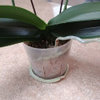Angraecum magdalenae
mrbreeze
15 years ago
More Discussions
This is certainly one of my favorite Angs and has one of the most potent fragrances of any orchid I've bloomed. For whatever reason, the flower this time is about half the size of last time and is comparitively distorted.
Two years ago:
{{gwi:207071}}

xmpraedicta
carolinn_on
Related Professionals
New Bedford Landscape Architects & Landscape Designers · Harvey Landscape Architects & Landscape Designers · Mooresville Landscape Contractors · Centereach Landscape Contractors · Clayton Landscape Contractors · Flagstaff Landscape Contractors · Hawaii Landscape Contractors · Oak Forest Landscape Contractors · Panama City Beach Landscape Contractors · Pompano Beach Landscape Contractors · Ramsey Landscape Contractors · River Ridge Landscape Contractors · Woodland Landscape Contractors · Sun Valley Landscape Contractors · Bull Run Specialty Contractorsbolero
bcfromfl
mrbreezeOriginal Author
bcfromfl
xmpraedicta
mrbreezeOriginal Author
Charm
bcfromfl
bcfromfl
xmpraedicta